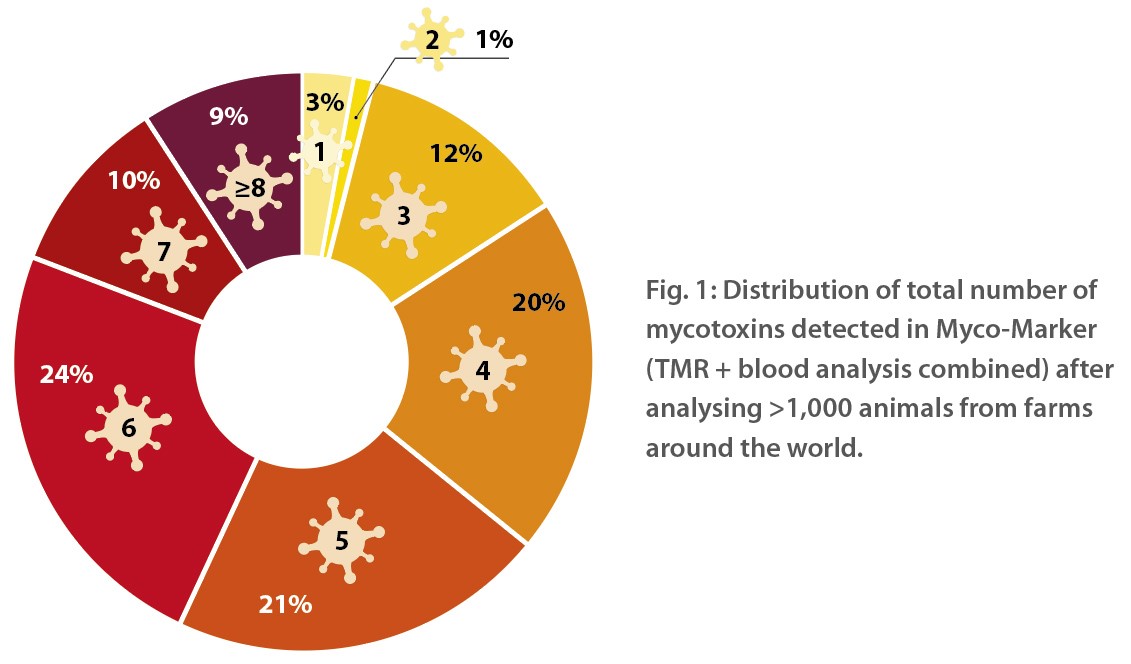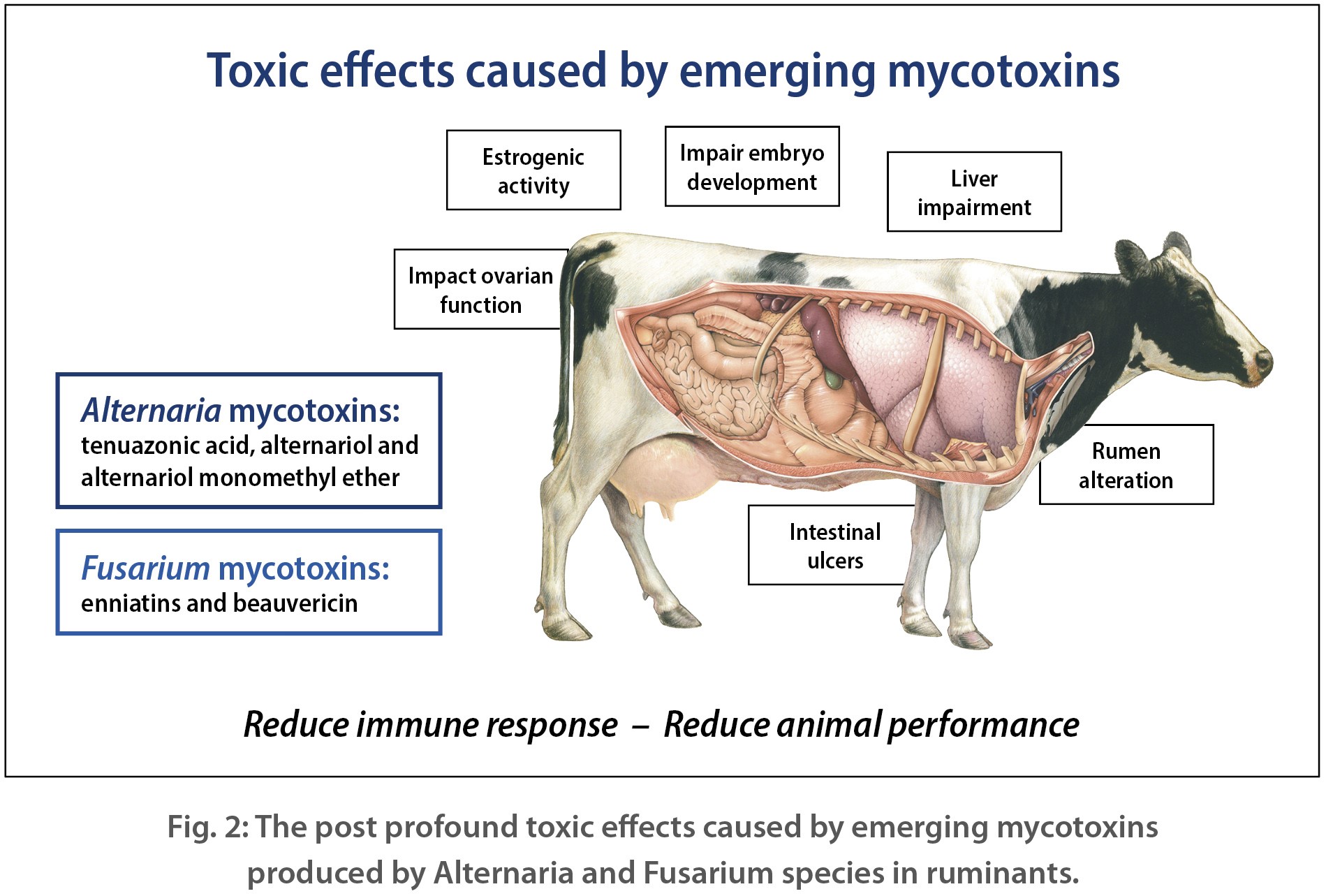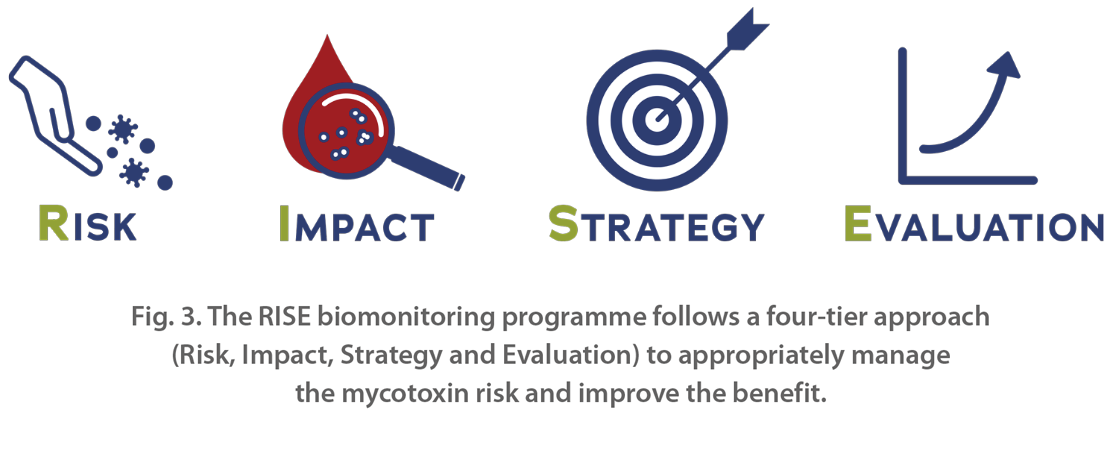Ruminant diets are associated with an increased risk of mycotoxin exposure compared to monogastric animals with a less varied diet. Recent evidence confirmed cows have the greatest exposure to mycotoxins, in part because of high forage contamination. However, there is the common misbelief that ruminants are not susceptible to mycotoxins as they are naturally protected against mycotoxins.
The myth could be partially true as rumen microflora, under ideal conditions, may be able to detoxify certain mycotoxins. But rumen environment is easily altered, besides, some mycotoxins cannot be degraded, or even, some can be transformed to compounds with a higher toxicity level (each mycotoxin is a distinctive molecule, and it requires specific individual attention). As rumen cannot solve the mycotoxins challenge, mycotoxins are considered an important limiting factor to achieve the maximum potential from the herd. Not only because of acute mycotoxicosis, easily discovered with clinical observations, but also problems caused after chronic exposure, even to low levels, that are able to cause unnoticeable problems. Such chronic exposure causes severe economic losses through clinically ambiguous changes in rumen environment, immune response, reproductive system and in feed intake. Because by the time clinical signs become identified, significant economic losses may have already occurred due to less visible but costly impacts. For this reason, it is crucial to achieve the maximum potential from the herd by evolving to evolve the mycotoxin management from a reactive approach based on clinical signs to a proactive identification of contamination through comprehensive biomonitoring programs.
Combining TMR and blood analyses
The lack of accurate evaluation tools for assessing the real mycotoxin impact on cows leaves the producer with doubts. However, the introduction of mycotoxin biomarker analysis at an industrial level has enabled precise measurement of the mycotoxin systemic exposure and its impact on animal performance and health. For the first time it is possible to achieve what the scientific community, for a long time, theorized as the best method to correctly assess the true exposure of animals to mycotoxins. By detecting them and their metabolites in bodily fluids, in this case blood, Innovad has validated and patented a method to currently determine 36 different mycotoxin biomarkers in blood using FTA cards. The cards offer a simple means to easily collect blood spots and dispatch them to our laboratory for analysis without restrictions.

Biomarkers discovered real risk
The TMR mycotoxin analysis combined with blood analysis, provides a more complete overview of the overall mycotoxin risk. Already, a few months after launching the service (since July 2022 in ruminants), more than 1,000 blood samples from ruminants (cows, beef, and sheep) around the world have been analysed. The considerable volume of analytes tested has enabled an unprecedented reliable assessment of actual mycotoxin exposure on ruminant farms. Firstly, a mycotoxin risk was identified in all the studied farms when blood analysis was added whereby 64% of farms were co-exposed to five or more mycotoxins (Figure 1). Secondly, a higher number of mycotoxins was detected in blood than in feed, which reveals the greater ability of the former to better detect the true exposure of mycotoxins. It is also worth stressing that the emerging mycotoxins produced by Alternaria (like tenuazonic acid) and Fusarium (enniatins and beauvericin) were the most prevalent mycotoxins detected in blood from ruminants (Table 1).

Toxic consequences from emerging mycotoxins
Because of their large presence, the toxic impact of these emerging mycotoxins started to be investigated and all the new findings raise serious concerns about the harmful character of these mycotoxins (Figure 2). Most of the Alternaria mycotoxins are well known to have estrogenic activity as they are able to bind and activate oestrogen receptors. In other words, they cause reproductive problems. This is relevant as up until recently it was generally believed that zearalenone was the only mycotoxin that can cause this type of symptoms. Interestingly, it was recently discovered that the co-occurrence of Alternaria mycotoxins with zearalenone can potentiate an accumulative estrogenic toxic effect. On the other hand, tenuazonic acid can seriously damage intestinal tissues and induce intestinal haemorrhage where even sub-acute exposure has been linked with bloody diarrhoea.

With regards to emerging Fusarium mycotoxins (enniatins and beauvericin), all studies reveal that they can exert a significant negative impact on intestinal tissues. For example, enniatin A1 was twice as toxic as deoxynivalenol in intestinal cells. Additionally, some studies demonstrated a toxic effect of beauvericin and enniatins on the reproductive system as they all altered the production of sexual hormones such as oestradiol and progesterone in ruminants. Also, beauvericin impaired the development of oocytes and early embryos. Importantly, emerging mycotoxin can also have a big impact on rumen. For example, beauvericin and enniatins have strong antibiotic properties and they can modify functional microflora of the rumen. Also, it should not be forgotten that all mycotoxins exert some level of immunocompromising effect and data from several studies suggest that these emerging mycotoxins are capable of impairing the immune response, therefore, predisposing animals to other infections as mastitis.
With a number of clinical studies having demonstrated that co-exposure to mycotoxins exerts a synergistic or negative additive toxic impact, the high level of co-exposure to several emerging mycotoxins in our global blood survey via Myco-Marker® raises concerns. This is especially true given the high rate of emerging mycotoxins where, for example, enniatin B and beauvericin or enniatin B and alternariol combinations were linked with significant toxic effects to the farmed animals.
Evaluating detoxifier capacity
The Myco-Marker service on >1,000 ruminant animals confirmed that dairy farms around the world are continually exposed to several mycotoxins simultaneously, causing economical losses. Until now, the use of mycotoxin binders has been the most common mitigation practice on farm, but their efficacy has been evaluated only through a simple in vitro binding test. However, as the European Food Safety Authority (EFSA) has concluded, such simple tests performed “in the glass” do not sufficiently mimic the conditions in the digestive tract and cannot be used to demonstrate efficacy under practical conditions. State of art mycotoxin biomarker research with the University of Gent in Belgium revealed the in vivo detoxification efficacy of Escent® under multi-mycotoxin exposure scenarios.
Efficacy under real farm conditions
However, it was indispensable to test the detoxifier technology in real farming conditions, where the animals are simultaneously confronted to several stress factors, like climatic conditions, infections, etc. The Myco-Marker® tool was deployed alongside overall performance as well as and clinical symptoms. The analyses revealed that systemic mycotoxin levels were widely reduced (or even completely removed) when animals were treated with the feed additive for a few weeks. For example, one dairy farm in the United States was suffering an expected high number of abortions. Blood analysis could detect the high exposure to estrogenic mycotoxins as zearalenone, alternariol and alternariol monomethyl ether. Two months later after a detoxification treatment, only one no estrogenic mycotoxin at low concentration was detected in blood. The removal of estrogenic mycotoxins from the blood was correlated with the decrease of abortions few weeks. In another dairy farm where detoxification strategies were applied, it was possible to increase five percent the milk yield when mycotoxins detected in blood were reduced from seven to one. The findings from all field studies confirm unequivocally the solution drastically reduces systemic exposure to mycotoxins where it is really needed, that is, in the real-world environment.
Biomonitoring to optimise your mitigation strategy
The combination of the diagnostic tool with the detoxifier offers the producer the innovative RISE® biomonitoring program (Figure 3). The program follows a four-tier approach:
-
Risk: quantification of the true mycotoxin RISK combining raw materials, TMR and blood analysis
-
Impact: reveal the direct IMPACT of mycotoxins on animal performance and health, specific to the farm
-
Strategy: optimize the mitigation STRATEGY by proceeding to a fully informed decision regarding the optimum application of the scientifically proven detoxifier technology
-
Evaluation: measure the effectiveness of the mitigation strategy
In the last year, dairy producers have implemented the biomonitoring program and succeeded in managing mycotoxin-related stress with the help of the detoxifier technology.
 In conclusion, mycotoxin biomarker analysis is an essential step forward in mycotoxin stress management plans, as for the first time it measures the true mycotoxin risk and the efficacy of mitigation strategies. The comprehensive biomonitoring program provides the producer with the ability to quantify the real benefit and ROI of the detoxifier technology specifically for their own farm, in relation to animal performance and health. And, of course, save hundreds of thousands or millions. Accurate mycotoxin biomonitoring data analysis will help to properly follow up on the toxin risk and adapt effective mycotoxin mitigation strategies to ensure optimal performance.
In conclusion, mycotoxin biomarker analysis is an essential step forward in mycotoxin stress management plans, as for the first time it measures the true mycotoxin risk and the efficacy of mitigation strategies. The comprehensive biomonitoring program provides the producer with the ability to quantify the real benefit and ROI of the detoxifier technology specifically for their own farm, in relation to animal performance and health. And, of course, save hundreds of thousands or millions. Accurate mycotoxin biomonitoring data analysis will help to properly follow up on the toxin risk and adapt effective mycotoxin mitigation strategies to ensure optimal performance.